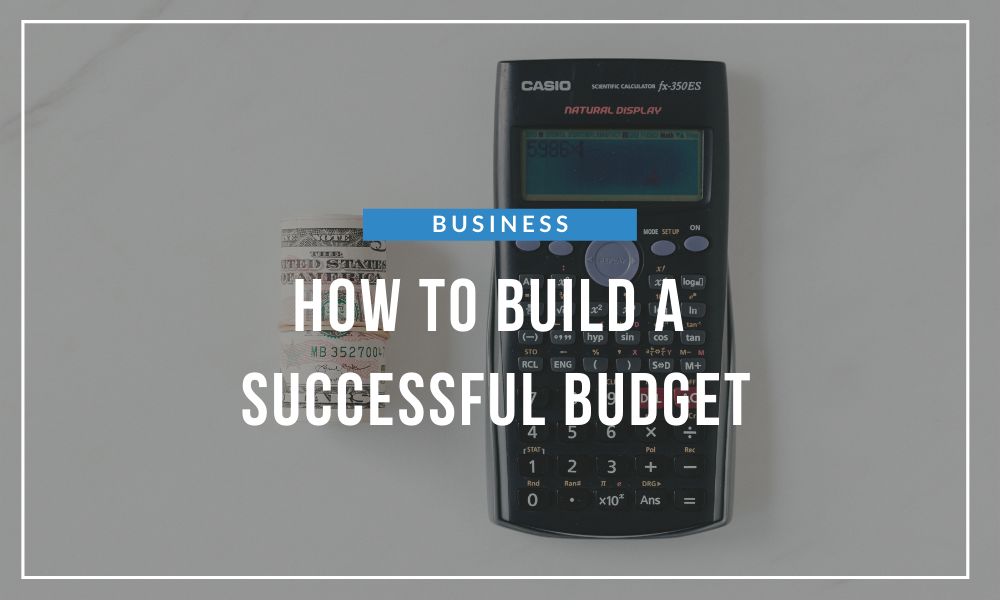As Benjamin Franklin once said, “By failing to prepare, you are preparing to fail.” So, let’s prepare now for your future success with a strong budget.
For business owners, having a budget for the New Year is an important part of financial preparation. But for some business owners, just the thought of having to prepare a budget makes them anxious. The idea of adding another item to your to-do list might actually push you over the edge, especially this year. Or maybe you just don’t know where to start. Either way, a budget is a critical step to your success, so reach out! System Six, your current bookkeeper or your CFO can help!
The budgeting process allows business owners to think about how much they will earn and how much they will spend in the following year. It can be as detailed or as summarized as you like. The goal is that a budget will ultimately help the business owner throughout the year determine if the business is on track financially through the use of budget versus actual reporting. So you’ll know month by month when and where to make expense changes or where you may be exceeding your revenue expectations.
Where Do I Start with a Budget?
Preparing a budget may sound like an impossible task. Keep in mind that this process can be as simple as you want it to be the first year and then revised and improved upon in subsequent years.
The most effective way to build your budget is to align your data with the accounts in your financial system (i.e., QBO, Xero, Sage, etc.) and ultimately to input the budget into your system for easy reporting next year. At System Six, we are here to work with our clients and other business owners to help them through this process.
Whether you have prepared a budget before or not, one of the best places to start is by reviewing financial statements for the current and prior two years, making notes on some key pieces of information.
- Do you notice any revenue trends? Are there certain months where you earn most of your revenue each year? Do you see a rather steady revenue increase each month?
- Are there any atypical income sources in those years that may not recur next year?
- Are your Cost of Goods typically a certain percentage of your revenue each month? Are there ever variations in certain months that need to be planned for?
- Are there any atypical expenses in those years that may not recur next year?
- Are there amounts you want categorized differently on your statements next year?
What’s the Point of a Budget?
Building your budget will vary some depending on your revenue model. However, in most cases, when determining your revenue budget, you will want to include realistic stretch goals. A budget needs to be achievable. There are other business growth documents you can use to evaluate and incentivize a sales team, for example, but a budget should be a realistic expectation of next year’s financial statements taking into account known external factors and changes. The expectation is that you will be able to run budget versus actual reports next year and be able to determine if your business is on track to your anticipated (budgeted) bottom line. If you are, great job! If not, you’ll be able to see where the business has gone astray and make real-time (monthly) adjustments to get back on course towards your initial plan.
How Detailed Should My Budget Be?
If this is your first time preparing a budget, our recommendation is to keep it simple! We don’t want you to feel like your budget is more trouble than it’s worth. If you are a Budgeting Pro, you can make your budget as detailed as you like. Either way, you will want to match your budget data to the Chart of Accounts inside your Financial System (i.e., QBO, Xero, etc).
You can enter your revenue to the top level called Revenue/Income or you can split it between your various sub-Revenue accounts. The same is true for all layers within your Chart of Accounts, including Cost of Goods and Expenses, being as detailed as you like or simply entering to the parent/summary/header accounts that you prefer. You can even choose to simply enter annual amounts for all accounts which will auto-split evenly across all 12 months of the year. Just a quick note that if you enter budget entries to the Summary accounts, and then next year actual expenses are entered to Sub-Accounts (more detailed), you will want to run Summarized Budget versus Actual reports in order to see the variances at the Summary level. But don’t worry, this is just fine; your budgeting efforts are still well worth the time! You may find this is all you need for several years.
At this step in the process, having reviewed both current year and prior year financial statements, it is up to you to determine next year’s annual budgeted revenue. An estimate is fine at this point based on what you know about your business. It is helpful to forecast where you think your revenue will be at the end of the current year in order to have a solid starting point for next year’s budget.
How Do I Determine Budgeted Revenue?
You may be wondering how you calculate more detailed budgeted revenue. This will differ depending on the type of business you operate.
Different Types of Businesses
- Subscription or Donor/Membership-Based organizations typically track their subscribers or donors/members by level or group and price. They know how many members they anticipate for next year and what revenue that equates to.
- Service or Project-Based organizations typically track their services by price. They anticipate a certain number of services for next year and what revenue that equates to.
- Inventory/Product sales organizations typically track their product sales by product. They anticipate a certain number of product sales for next year and what revenue that equates to.
These calculations are made with information pulled from a Point of Sale system or Membership database, which may or may not be directly integrated with the financial system.
More Complex Business Structures
What if your financial system is set up with even more detail, such as departments, locations or class structure? All of these layers can absolutely be taken into account when creating your budget. Essentially the process is the same; you will simply repeat the process for each of these layers. In the end, when the budget is entered into your financial system for each of those layers, the summarized version of your budget will “roll up” to your master budget. It is important to note that completing a budget process to this level of detail can be quite time consuming, especially if this is new to you or if you are taking on this challenge alone without any supporting departmental staff.
Special Revenue Considerations
As revenue is estimated for next year, it is important to include potential key business changes, such as new product lines/products or expanding business areas. Conversely, it’s also important to consider the discontinuation of any business lines/products or the closure of any business areas. Other key changes might include the impact of price increases, including not only the anticipated increase, but also any customer impact as a result of those increases (i.e., cancellations, etc.).
What’s Next?
Once you have this detailed annual budgeted revenue, the next step is to determine how to spread it out monthly for next year’s budget. If you have chosen not to calculate annual revenue in such detail, simply use the annual budgeted revenue for the business as a whole you determined above.
Monthly Revenue Modeling
Once you know what you are expecting for next year’s annual revenue, it’s important to know how to spread out that revenue each month. Depending on the type of business you operate, there are several options to choose from. Please note that if your revenue is consistent month to month, you can choose to enter your annual revenue, skipping this step altogether, allowing the system to allocate revenue evenly by month (simply dividing by 12).
Cyclical Revenue Modeling
Does your business generate most of its revenue during a specific month or quarter of the year? For example, is your business dependent on New Year’s resolutions (i.e., gym memberships, etc)? Or, is your business dependent on holiday sales (busiest from Oct-Dec)? If so, then your business would be considered cyclical, with more revenue being entered to specific months during the year. For a cyclical business, it is important to budget revenue next year by looking at the historical trends for those key months, being realistic about growth, and then allocating revenue in the other months similarly.
Incremental (or Percentage Growth) Revenue Modeling
Does your business typically grow a certain percentage each year or each month? If so, calculate the growth percentage and see if that applies consistently throughout the year or in certain quarters. Based on what you find, this percentage growth should be applied similarly to revenue amounts for next year.
Breakeven Revenue Modeling
Would you like to budget revenue based on the minimum amount needed to cover anticipated expenses for next year? This is called Breakeven Budgeting. You can apply revenue Cyclically or Incrementally, but by lower amounts or even reducing revenue from the current year. In this model, first budget expenses, budgeting revenue last, with the goal being a $0 Net Profit/Bottom Line. The purpose of this model allows business owners to know that if they do not exceed budgeted expenses and at least meet budgeted revenue, they will not lose money at year end.
Expense Modeling
The expense side of the budget model typically uses percentage growth for key accounts. Most often, business owners will review current and prior year financial statements to gauge expense levels and increases year over year to estimate next year’s budget. Key areas to consider include:
- Cost of Goods Sold: Since these are industry or even business specific, you’ll want to review these in depth to determine what to expect for next year by month.
- Payroll: You’ll want to consider both cost of living increases as well as any anticipated performance increases. Keep in mind that payroll accounts can be in various places within the Chart of Accounts, depending on your layout, including Costs of Goods Sold and Admin/G&A, and may also split out owner wages separately.
- Employee Benefits: Benefits can unexpectedly increase, sometimes quite a bit year over year, so it can be helpful to reach out to your broker to get an idea of your increase for next year. Be sure to include any new benefits you may be implementing next. And similar to Payroll, these costs may also be found in several places on the P&L, including Cost of Goods Sold and Admin/G&A, with owner benefits oftentimes split out separately.
- Utility Increases: Although often considered a “fixed expense”, utility companies do increase their rates and utility expenses can be a large expense on the books. So taking a look at prior year increases can help determine next year’s budgeted expense.
- Revenue-based taxes: Depending on your state, revenue-based taxes are typically percentage based. So for budget purposes, setting them as the same percentage (of next year’s estimated revenue) as current year is generally a safe bet, unless you expect major changes to your business model.
- Other expenses: As the business owner it is important to look at the other expenses on your books, determine what percentage increases are appropriate for next year or if there is another methodology that makes more sense for estimating next year’s budgeted amount. You know your business best and are in the best position to make those estimates.
So Where Do YOU Want to Start?
Having reviewed more about what you already knew or learned something new, where do you want to start with this important step towards your 2022 success?
How Can We Help?
If you are interested in some help with this project, please click on this link and connect with us at System Six. It will take you to a short list of questionnaires to help us determine how we can best serve you in this process.




